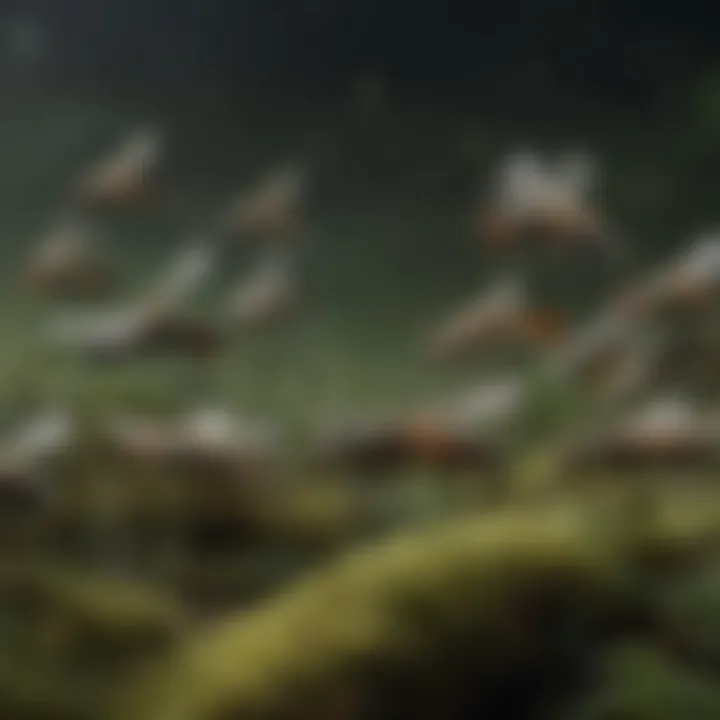Midge Fly Control: Strategies and Best Practices


Intro
Midge flies present unique challenges for woodland ecosystems, where their populations can significantly impact both the environment and human activities. Understanding these challenges is essential for effective management, which not only protects the woodland habitats but also aids in the well-being of various species that rely on these ecosystems. This guide aims to provide insights into Midge Fly Control, addressing their biology, the environmental factors that affect their populations, and an array of management strategies to combat infestations.
Understanding Woodland Ecosystems
Understanding the intricate dynamics of woodland ecosystems is crucial for developing effective midge fly control strategies. Healthy forests harbor a rich diversity of life, which in turn supports balanced ecosystems.
Importance of Biodiversity in Forests
Biodiversity in forests is vital. It contributes to resilience against pest outbreaks, enhances ecosystem productivity, and provides various services such as water filtration and carbon sequestration. Healthy populations of predators and parasites can help keep midge fly numbers in check, emphasizing the need for preserving biodiversity.
Role of Forests in Climate Regulation
Forests play a pivotal role in climate regulation. They absorb carbon dioxide, producing oxygen and regulating temperature. When forests suffer from high midge fly populations, their ability to perform these crucial functions can be compromised. Thus, implementing control measures is not only about reducing midge populations but also about maintaining the overall health of the ecosystem.
"The balance of the woodland ecosystem is critical, not just for managing pests like midge flies, but for the entire biosphere."
Sustainable Forestry Practices
Sustainable forestry practices are key to managing midge flies effectively while minimizing environmental impact. These practices involve careful planning and implementation of strategies that align with ecological health and long-term productivity.
Principles of Sustainable Forestry
- Ecological Integrity: Ensuring that forest management maintains the natural processes and biodiversity of the area.
- Economic Viability: Promoting practices that support local economies without compromising the forest’s health.
- Community Involvement: Engaging local communities in decision-making processes, fostering stewardship and a sense of ownership.
Case Studies of Successful Implementations
Several case studies illustrate successful midge fly control through sustainable forestry. These examples often highlight the integration of biological control measures with habitat management. For instance, a forest management group in the Pacific Northwest introduced native predatory insects to mitigate midge populations, resulting in balanced insect dynamics without the need for chemical inputs.
Woodland Stewardship Techniques
Stewardship techniques are essential for maintaining the health of woodland areas while addressing pest management like that of midge flies.
Forest Management Plans
A well-crafted forest management plan outlines strategies to promote ecological diversity, manage resources wisely, and control pest populations sustainably. These plans often involve regular monitoring of pest populations to anticipate outbreaks before they escalate.
Conservation Strategies
Conservation strategies, such as protecting key habitats and implementing buffer zones, play a significant role in reducing midge fly populations. Enhancing natural habitats can support predator species that keep midge flies in check. Additionally, incorporating native vegetation may create ecological balance, further decreasing reliance on chemical control methods.
In summary, the interplay between understanding woodland ecosystems and implementing effective midge fly control requires a multifaceted approach. By focusing on sustainable practices and stewardship techniques, forestry professionals and enthusiasts can tackle the challenges posed by midge flies responsibly.
Preamble to Midge Flies
Midge flies represent a diverse group of small insects that are often present in woodland ecosystems. Their existence is significant for various reasons, both ecological and socioeconomic. Understanding midge flies and their behaviors is integral for forestry professionals and academics who seek to manage these insects effectively. In particular, knowledge of their biology, lifecycle, and ecological roles informs strategies for control and mitigation in affected areas.
Midge flies are known for their rapid reproduction and adaptability, which can lead to large populations under favorable conditions. This characteristic makes them challenging to manage. They are not only pests but also play a crucial role in food webs and ecosystem dynamics, serving as prey for various wildlife species. Additionally, midge flies contribute to pollination, although their bites can pose health risks to humans and animals.
Overall, a comprehensive grasp of midge flies can lead to better management practices in woodlands, thereby preserving both ecological balance and economic stability.
Biology and Lifecycle of Midge Flies
Morphology
Midge flies exhibit a unique morphology that distinguishes them from other insects. These small flies typically range from 1 to 10 mm in length and feature elongated bodies and long legs. A notable characteristic is their wings, which are often delicate and have a characteristic fringed appearance. This morphology allows them to thrive in humid environments, as their lightweight structure aids in buoyancy during flight.
The unique features of midge fly morphology enhance their survival in various habitats. However, their delicate physical traits can make them vulnerable to extreme weather conditions, impacting their populations. Therefore, while their morphology has ecological advantages, it also presents challenges regarding their resilience in changing climates.
Reproductive Strategies
The reproductive strategies of midge flies are quite complex. These insects often engage in swarming behavior, which attracts mates and increases the likelihood of successful reproduction. Midge flies can produce large numbers of eggs, enhancing their chances of population survival.
A key aspect of their reproductive strategy is the ability to reproduce multiple times in a short period. This rapid generation turnover results in quick population booms, making control efforts more challenging. The advantage here is their ability to quickly colonize suitable habitats, but the drawback is the potential for overwhelming numbers that disrupt other woodland species.
Development Stages
Midge flies undergo a distinctive set of developmental stages, which include the egg, larva, pupa, and adult phases. The larval stage is particularly significant, as midge fly larvae often inhabit aquatic environments, feeding on organic matter. This lifestyle not only supports their growth but also impacts the aquatic ecosystem they inhabit.
The various developmental stages allow midge flies to persist through different environmental conditions. However, the larval stage can be sensitive to pollution and habitat disruption, influencing their survival. Understanding these stages is crucial for developing effective management practices to control midge fly populations.
Ecological Role of Midge Flies
Food Source for Wildlife
Midge flies serve as an essential food source for many species within woodland ecosystems. Birds, fish, and other insects rely on midge flies for nutrition. This role highlights their importance in maintaining ecological balance, as their presence directly supports predator populations.
One key characteristic of midge flies as a food source is their abundance during certain seasons. This availability is beneficial for wildlife, particularly during breeding seasons when organisms need more resources. However, sudden population declines can negatively affect species that depend on midge flies for food, leading to potential ecological disturbances.
Pollination Activities


Midge flies also contribute to pollination activities within their environments. While they are not the primary pollinators, they assist in the pollination of various plants as they move between flowers in search of nectar. This interaction supports plant reproduction and consequently the overall health of ecosystems.
The unique feature of midge flies in pollination involves their small size. They can access flowers that larger pollinators may overlook, thereby enhancing the genetic diversity of plant populations. However, their role in pollination is often overshadowed by more prominent pollinators, making it essential to recognize their contributions to biodiversity and ecosystem resilience.
"Understanding the multifaceted roles of midge flies can lead to more effective management strategies that respect ecological integrity while addressing pest concerns."
The Impact of Midge Flies
The discussion of midge flies is not solely centered on their biology or environmental niches; their impact extends to economic and health dimensions as well. Understanding this impact is crucial for managing infestations effectively. Midge flies, though small, can have significant consequences for both ecosystems and human communities. This section delves into two primary aspects: their role as forest pests and the associated health concerns.
Midge Flies as Forest Pests
Midge flies are often regarded as forest pests, with serious consequences for woodland environments. Their impact can be evaluated through economic implications and ecological balance each outlined below.
Economic Impact
The economic impact of midge flies can be profound, especially in regions reliant on forestry and agriculture. These insects can cause damage to crops and trees, leading to a loss of revenue for farmers and forest managers. The decline in crop yield can strain local economies heavily dependent on agriculture.
In this article, we emphasize the importance of recognizing midge flies as a significant factor affecting economic livelihoods. The costs associated with control measures and the potential loss from infestations are critical components.
Key Feature: Midge flies may reproduce rapidly, causing populations to explode under the right conditions.
Advantages: Early detection and intervention can mitigate some economic damages. Understanding midge fly behavior can lead to more targeted, effective control programs, ultimately safeguarding economic resources.
Ecosystem Disruption
Midge flies are not just nuisances; they can disrupt ecosystems significantly. High populations can lead to changes in food webs and competition for resources.
Ecosystem disruption manifests in altered plant growth and impacts on wildlife that rely on various food sources, including smaller insects and plants that might be damaged by midge larvae.
Key Characteristic: Their presence can indicate shifts in environmental conditions indicative of broader ecological changes. We focus on this aspect in the article, highlighting how midge fly infestations can serve as early warnings of changing health in forest ecosystems.
Disadvantages: Disruptions may not be reversible, and hence integrating midge fly control strategies is essential to maintain ecological balance.
Health Concerns Related to Midge Fly Bites
Midge fly bites are often overlooked in discussions about pest impacts, yet they can lead to serious health concerns for humans and animals alike. The focus on two aspects here is critical for comprehensive understanding.
Allergies
Midge fly bites can lead to allergic reactions in sensitive individuals. Symptoms may include redness, swelling, and itching, which can be severe in some cases.
With an increase in outdoor activities, understanding allergies related to these bites is essential. This article addresses the rising incidence of allergic reactions and the necessity for awareness and preventive measures.
Key Feature: Individual susceptibility varies, highlighting the importance of personalized management strategies.
Benefits: Recognizing signs of allergic reactions early can prompt timely medical intervention.
Disease Transmission
There is a potential for disease transmission through midge flies, particularly in regions where these insects are abundant. Cases of disease spread through bites, although less common, are notable.
This section of the article emphasizes the significance of awareness regarding health risks associated with midge flies. Understanding that they can harbor pathogens necessitates preventive measures in forest management practices.
Key Characteristic: Disease transmission scenarios can escalate in regions with high density midge fly populations.
Disadvantages: Continuous monitoring and potential health impacts could lead to increased management costs in the long term.
Identifying Midge Fly Infestations
Identifying midge fly infestations is a crucial first step in managing their populations. Understanding the signs of an infestation can lead to timely interventions, which can mitigate damage to woodlands and reduce health risks associated with bites. Accurate identification enables forest managers and enthusiasts to tailor their control strategies effectively, ensuring a more targeted response.
Recognizing the specific elements associated with midge flies helps to distinguish them from other insects, which is vital for choosing the appropriate control measures. Infestations are often subtle and, without careful observation, can escalate. Therefore, investing time in identification techniques is not just practical; it is often critical for successful management practices.
Signs of an Infestation
Visual Cues
Visual cues are a primary method for detecting midge fly infestations. Observing the numbers of midge flies in a given area can indicate an infestation's severity. These flies are typically small, measuring only a few millimeters in length, and often found in large clouds near water sources or damp areas. One key characteristic is their distinctive flight pattern, which can help differentiate them from other insects.
These cues help practitioners to quickly assess the situation. The presence of midge flies can show issues in specific environments, such as standing water, which provides breeding grounds. However, careful observation is needed, as other small flying insects may also be present. This method has its advantages; it requires no special equipment, just keen eyesight and familiarity with patterns.
Sampling Techniques
Sampling techniques are more systematic ways to confirm the presence of midge flies. This includes capturing samples using nets or sticky traps, which can provide quantitative data on population size and species present. A key characteristic of sampling techniques is the ability to gather precise data on infestation levels, which helps in planning control strategies.
These methods are often beneficial as they provide a more reliable assessment than visual observation alone. They allow for the monitoring of environmental conditions, aiding in understanding population dynamics over time. However, these techniques may require additional equipment and skills, which can be a hurdle for some practitioners.
Differentiating Midge Flies from Other Insects
Key Identifiers
Key identifiers serve as a fundamental aspect of distinguishing midge flies from other insect species. Particular physical features help in this identification process. For instance, midge flies have long legs and a distinctive body shape that resembles mosquitoes but are generally smaller.


Identifying these features aids in avoiding confusion with other insects that may not require control. This is a beneficial method for ensuring accurate identification of the pest and focusing on proper management strategies. However, reliance only on visual identifiers may lead to false conclusions if not corroborated with other methods.
Look-Alike Species
Look-alike species can complicate the identification process. Midge flies share traits with other insects, such as mosquitoes and certain gnats. This similarity can lead to misidentification and consequently inappropriate control measures. One key characteristic is the behavior; midge flies tend to swarm near water, which can help differentiate them.
Understanding these look-alikes can highlight the importance of accurate field guides and reference materials. Misidentifying a species can result in wasted resources and time. Therefore, practitioners should invest time into learning about species found in their environments, making it a wise choice for effective management.
Control Methods for Midge Flies
Control methods for midge flies are essential for maintaining healthy woodland ecosystems. Effective strategies can significantly mitigate the impacts these pests have on both plant and animal life. Midge flies are not only a nuisance but can also affect biodiversity and the overall health of woodlands. Their control requires a multifaceted approach that recognizes the unique characteristics of these insects.
The strategies outlined below encompass chemical, non-chemical, and integrated pest management approaches, each with its own benefits and considerations.
Chemical Control Strategies
Insecticides Overview
Chemical control using insecticides can be a quick solution for addressing midge fly populations. These products target various stages in the life cycle of the flies. Common options include pyrethroids and organophosphates, which are known for their effectiveness.
The key characteristic of insecticides is their ability to rapidly reduce pest numbers. This makes them a popular choice for immediate relief when infestations are significant. However, caution is required. Insecticides may harm non-target species, such as beneficial insects and pollinators. Moreover, developing resistance can diminish their effectiveness over time.
Insecticides can be beneficial in situations where rapid population control is essential. Their unique feature lies in their immediate impact. Yet, over-reliance can lead to ecological imbalances.
Application Techniques
Proper application techniques are crucial to maximize the effectiveness of insecticides. Techniques vary from spray application to targeted treatments using fogging. Each method has its benefits and can be selected based on the specific conditions of the infestation.
The key characteristic of these techniques is precision. This ensures that the insecticide is delivered effectively without excessive environmental impact. Proper timing and dosage are essential in preventing deflection into non-target areas. Comprehensive training for applicators is vital to achieve the best results.
Application techniques enhance the benefits of chemical controls, but they also come with drawbacks. The wrong methods can lead to over-spray or miss-targeting, which can waste resources and cause environmental harm.
Non-Chemical Control Strategies
Biological Control Methods
Biological control methods offer a sustainable alternative to chemical pesticides. These methods involve introducing natural predators or parasites that specifically target midge flies.
The key characteristic is reliance on ecological balance. These biological agents can effectively reduce pest populations without significant environmental impacts. This makes biological control methods beneficial in promoting long-term pest management.
Biological control methods can be slow to yield results. Their success depends on maintaining the stability of introduced species within the ecosystem, unlike insecticides that offer immediate results. Understanding the local ecosystem is critical for these strategies.
Environmental Manipulation Techniques
These techniques focus on modifying the environment to discourage midge fly populations. For example, reducing stagnant water or altering vegetation can disrupt breeding cycles.
The key characteristic of environmental manipulation is its proactive approach. It directly affects the habitat conditions favorable for midge flies. By doing so, it reduces the likelihood of infestations. This method is beneficial as it encourages sustainable practices and habitat integrity.
However, manipulation techniques may require significant effort and time for effective implementation. It also relies on ongoing management practices to sustain results over the long term.
Integrated Pest Management Approaches
Combining Methods
Integrated pest management (IPM) approaches combine various control methods to manage midge flies effectively. This includes utilizing both chemical and non-chemical methods to maximize control while minimizing negative impacts.
The key characteristic of combining methods is versatility. This approach allows for tailored solutions based on specific infestations, ecology, and available resources. The ability to integrate various strategies can enhance the effectiveness of control measures.
While beneficial, IPM requires careful planning and understanding of ecology. It can also lead to increased costs in management, but it provides a comprehensive framework for pest control.
Monitoring and Assessment
Ongoing monitoring and assessment are critical components of any effective control strategy. Regular surveys and data collection can identify changes in midge fly populations and the effectiveness of control measures.
The key characteristic of monitoring is adaptability. With accurate data, management strategies can be adjusted to address emerging issues and improve effectiveness. This makes it a beneficial choice for long-term planning.
Monitoring requires resources and commitment but ultimately leads to informed decision-making. It can prevent further infestations and promote overall ecosystem health.
Best Practices for Midge Fly Control
The control of midge flies is essential in maintaining the ecological balance within woodland environments. Effective management strategies help minimize their populations while preserving the integrity of the ecosystem. Understanding best practices provides a framework for professionals to approach midge fly control methodically. These practices include preventive measures and sustainable stewardship that not only focus on immediate control but also on long-term ecological health.
Preventive Measures
Preventive measures play a crucial role in midge fly control. Preventing infestations is more efficient than trying to mitigate them after they occur. The two primary areas of focus in preventive strategies are habitat modification and timely management activities.
Habitat Modification
Habitat modification refers to altering the landscape to make it less conducive for midge flies. This strategy includes strategies such as reducing standing water, which serves as breeding grounds. A key characteristic of habitat modification is its focus on long-term management rather than short-term fixes. By making an area less suitable for midge flies, the likelihood of infestation can be significantly lowered.
The unique feature of habitat modification is its environmental friendliness. It often leads to broader ecological benefits. For example, reducing stagnant water not only affects midge population but can be advantageous for various other species as well. However, this method does have its disadvantages. Implementing such changes requires careful planning and resources, and it may not be feasible in all circumstances.


Timing of Management Activities
Timing of management activities is another pivotal element in midge fly control. Implementing strategies at the right moment—such as before breeding seasons—can hinder their development. The key characteristic of this approach is the synchronization with the midge lifecycle. This makes it a beneficial choice as it maximizes the impact of the control methods used.
A unique feature of timing is its reliance on observation and understanding of local weather and biological patterns. While this method is not without challenges, such as the need for consistent monitoring, its advantages are considerable. It allows for targeted interventions that can be more effective than broader, less-timed efforts.
Sustainable Practices in Woodland Stewardship
Sustainable practices in woodland stewardship further enhance midge fly control efforts. These practices aim to promote ecological balance while managing infestations effectively. They include encouraging biodiversity and minimizing chemical use.
Encouraging Biodiversity
Encouraging biodiversity involves enhancing the variety of plant and animal life within a habitat. Increased biodiversity can lead to a more resilient ecosystem, which is better able to withstand pest pressures. A core characteristic of this approach is its holistic nature; by fostering a wider range of species, the ecosystem becomes more balanced.
The distinct advantage of encouraging biodiversity is that it promotes an array of natural predators to midge flies. This helps in managing midge populations naturally. However, it requires time and careful planning to achieve these outcomes. Additionally, it may not provide immediate results but rather contributes to long-term stability.
Minimizing Chemical Use
Minimizing chemical use in midge fly control is another fundamental aspect of sustainable practices. Reducing reliance on chemical insecticides helps protect non-target species and preserves overall ecological health. This approach is favored as it aligns with the principles of integrated pest management.
The unique aspect of minimizing chemical use is the integration of alternative control methods, such as biological controls, which may offer more sustainable solutions. Each chemical application can have unintended consequences, so reducing their use is a prudent consideration. The balance between effective pest control and ecological conservation can be challenging, but the benefits are significant when managed carefully.
Effective midge fly control requires a combination of preventive and sustainable practices to achieve long-term ecological balance and pest management.
Case Studies in Midge Fly Control
The case studies presented in this section are essential for understanding how midge fly control strategies are effectively implemented across various contexts. These real-world examples provide valuable insights into successful tactics and the pitfalls encountered. Evaluating these cases allows professionals in the field to draw lessons from both effective programs and failed attempts. This knowledge is crucial for shaping future midge fly management efforts.
Successful Control Programs
Regional Examples
Regional examples of successful midge fly control often showcase tailored strategies that accommodate local environmental conditions. For instance, programs in the southeastern United States have effectively employed targeted pesticide applications combined with biological controls, like the introduction of natural predators to midge flies. One key characteristic of these programs is their adaptive management approach, allowing for adjustments based on ongoing monitoring and evaluation.
These regional programs highlight the importance of community engagement and collaboration among stakeholders. By fostering local partnerships, these initiatives gain support and enhance outreach efforts. This cooperation also enriches data collection, resulting in more accurate assessments of midge fly populations and control effectiveness. A unique feature of regional examples is the integration of educational workshops for local forestry professionals, encouraging them to share best practices and learn from each other's experiences. However, potential disadvantages include challenges related to varying stakeholder commitment levels and differing priorities across regions, which can complicate consistent implementation.
Innovative Techniques Utilized
Innovative techniques utilized in midge fly control have emerged from advances in technology and research. For example, the application of genetic control methods, such as the release of genetically modified organisms designed to reduce midge fly reproduction, presents a progressive approach. One notable characteristic of innovative techniques is their use of remote sensing tools that provide precise data on midge populations and their habitats, thus ensuring timely and informed decision-making.
These techniques are often regarded as beneficial due to their potential for sustainable long-term outcomes. Unlike traditional methods, they may minimize the reliance on chemical treatments, subsequently reducing environmental impact. A unique feature is the development of predictive models that assess the risk of midge fly outbreaks based on weather and ecological data. However, these techniques may necessitate a higher initial investment in research and technology. Additionally, public acceptance and regulatory hurdles can pose challenges for widespread adoption.
Lessons Learned from Failed Attempts
Common Mistakes
Common mistakes identified from failed midge fly control attempts serve as important learning points for practitioners. One prevalent issue is the lack of comprehensive pre-implementation studies. Programs that fail to assess local ecology and existing midge populations are prone to implementing ineffective strategies. This characteristic emphasizes the necessity of thorough site assessments and needs analyses before devising a control plan.
Furthermore, inadequate communication among stakeholders often leads to disjointed efforts. Many management plans overlook education for local communities, resulting in misunderstanding or resistance. A unique feature of these mistakes is the missed opportunity for leveraging local knowledge, which can offer valuable insights into midge fly behavior and local ecosystems. Ultimately, recognizing these mistakes can guide the re-evaluation of current strategies, facilitating more successful interventions in the future.
Importance of Adaptation
The importance of adaptation in midge fly control cannot be overstated. Adaptive management emphasizes the continual adjustment of strategies based on both real-time monitoring and feedback from implemented practices. This key characteristic allows for more responsiveness to emerging challenges, like changing midge populations or climate variations that affect their lifecycle.
Emphasizing adaptability promotes resilience in management programs. The dynamic nature of midge fly populations requires that control efforts evolve over time. A unique feature of this approach is the integration of recent research and data into ongoing practices. However, the necessity for continual assessment can strain resources and require more effort to document and analyze outcomes systematically.
Adaptation in pest management is not just a strategy; it is a vital practice that helps mitigate unforeseen challenges and improve overall effectiveness.
These case studies illustrate the variety of approaches taken to manage midge flies successfully. They also underscore the potential pitfalls and the importance of being adaptable and conscientious in decision-making.
Future Directions in Midge Fly Research
Research on midge flies is critical for developing effective control strategies. As these insects pose growing threats to forests and ecosystems, understanding their biology and behavior is vital. Future research can uncover new management techniques, especially in light of changing environmental conditions.
Advancements in technology can also provide fresh insights into midge fly populations and their interactions within ecosystems. To address the challenges of controlling these pests effectively, scientists must explore both innovative technologies and the impacts of climate change on their lifecycle and behavior.
Emerging Technologies for Control
Genetic Approaches
Genetic approaches involve manipulating the genes of midge flies to control their populations. This technique can help reduce the number of breeding individuals or modify behaviors that make them harmful. The ability to target specific genes allows for precise control, minimizing the impact on non-target species. Genetic modification is seen as a potential long-term solution because it does not rely on repeat applications or harsh chemicals. However, potential ethical considerations and long-term ecological impacts must be addressed.
Remote Sensing Tools
Remote sensing tools use technology to monitor and track changes in midge fly populations over large areas. These tools can provide real-time data on habitat conditions and midge fly presence. The key characteristic of these tools lies in their ability to collect data from a distance, making it easier to identify problem areas quickly. Remote sensing can also help in strategizing control measures efficiently. The challenge with this method is the need for substantial technical knowledge and equipment, which can be a barrier to some forest managers.
Investigating Climate Change Impacts
Climate change significantly affects midge fly populations and their behavior. Understanding these impacts will help in creating adaptive management strategies.
Shifts in Behavior
Midge flies may exhibit altered behavior as temperatures and weather patterns change. These shifts can influence their feeding, mating, and breeding habits. A key aspect of investigating these behavior modifications is understanding their impact on other species. Highlighting these shifts can be beneficial for formulating timely management responses. However, documenting changes can be complicated due to various influencing factors.
Changes in Distribution
As climate conditions evolve, midge flies may shift their distribution patterns. This can lead to new infestations in areas previously unaffected. Recognizing where midge flies move can help forest managers prioritize monitoring and control efforts. The unique feature of this change is that it may not only affect midge flies alone but can also disrupt local ecosystems as these insects interact with other species. Careful mapping and analysis of changes in distribution will be essential for proactive management.
Understanding the future directions in midge fly research is vital to address emerging challenges in pest management. By harnessing technological innovations and studying environmental influences, a more effective management strategy can be formed.







